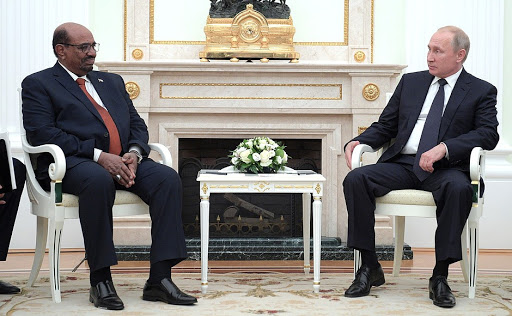
Russian Naval Base in Sudan: Extending Moscow’s Influence in Middle East and North Africa
Publication: Eurasia Daily Monitor Volume: 17 Issue: 168
By:

Russia is determinedly expanding its influence in Africa. On November 16, Russian President Vladimir Putin signed an order for the country to build a naval base on Sudan’s Red Sea coast, its first in Africa since the end of the Cold War. According to Putin’s instruction, the Russian navy is to build a base for 300 personnel and dock space for up to four warships, including nuclear-powered vessels (Pravo.gov.ru, November 16; see EDM, November 19). Sudan has leased Russia land for the naval “logistics center” for 25 years, with an option for decade-long extensions. Retired Admiral Viktor Kravchenko, a former chief of staff of the Russian Military-Maritime Fleet (Voyenno-Мorskoi Flot—VMF), estimates construction time for the facility to take three to four months (Interfax, November 17). The complex will be located near the Sudanese Navy’s main base at Flamingo Bay and just north of Port Sudan, the country’s main coastal port on the Red Sea.
The base agreement builds upon earlier Russian diplomatic initiatives with Sudan. In November 2017, Sudan’s then-president Omar al-Bashir—facing personal pressure from the United States—discussed the possibility of creating a Russian military base in his country during meetings in Sochi with Putin and Defense Minister Sergei Shoigu (Izvestia, November 25, 2017; see EDM, November 29, 2017 and December 6, 2017). Despite a 2019 coup that removed al-Bashir from power, discussions continued with his successor, Lieutenant General Abdel Fattah Abdelrahman al-Burhan. Two years later, on January 9, 2019, then–Russian Prime Minister Dmitry Medvedev approved a draft agreement with Sudan on a simplified procedure for the entry of warships into the ports of both countries as well as on broader bilateral military cooperation (RIA Novosti, January 9, 2019). Under the terms of the agreement, last month (October 2020), Russia transferred a UK-307 training boat from the VMF to Sudan (Vedomosti, November 11).
It is important to note the relatively modest dimensions of the planned new naval facility, at least initially. According to Russian military expert and Middle East specialist Iuri Liamin, “Let us make it clear again: This is not quite a [full-fledged] naval base but a logistics support center. This concerns the numbers, infrastructure and equipment” (Moskovsky Komsomolets, November 12).
The facility’s strategic importance outweighs its size, however, as a naval outpost in Sudan would expand maritime Russian influence in northeast Africa, along vital shipping routes in the Red Sea and in the Bab el-Mandeb Strait. An interim stated task for Russian warships deployed there could be to participate in anti-piracy patrols off Somalia, where the European Union’s Naval Force Atalanta (EU NAVFOR) had been operating since December 2008. As the European Council extended the Atalanta mission only until the end of December, Russian Sudan-based warships could assist in filling the imminent power vacuum there (Eunavfor.eu, accessed November 25).
Additionally, Russia’s naval facility at Tartus in Syria, which it has been expanding since intervening in the Syrian conflict, has altered the strategic equation of the Eastern Mediterranean by outflanking the North Atlantic Treaty Organization’s (NATO) control of the Turkish Straits. The new Sudan base will further augment Russia’s proximity to the Suez Canal, through which about 10 percent of all world maritime traffic passes, by providing a new naval stronghold south of that choke point.
Moreover, the Sudanese port will provide a more convenient stop-and-resupply opportunity for Russian VMF surface warships transiting from the Indian Ocean or Gulf of Aden to the Mediterranean—no longer forcing them to first travel all the way up the Red Sea, through the busy Suez Canal, and onward across the Eastern Mediterranean. And if the base in Sudan genuinely proves able to support nuclear-powered vessels, it could become a significant new operational location for Russia’s nuclear submarines. This would permit Moscow to project force eastward, into the Arabian Sea and Indian Ocean, currently reachable most easily by ship from Russia’s distant Pacific bases. A second benefit of Russian naval projections into the Arabian Sea is, of course, to “fly the flag” and support one of its most important regional partners, sanctions-plagued Iran.
The Russian government places its efforts in Sudan within the larger context of restoring influence in the Middle East and North Africa (MENA), lost after the 1991 disintegration of the Soviet Union. In October 2019, the Russian government hosted its first Russia-Africa summit in Sochi, attended by more than 54 African heads of state. A high-priority agenda item was deepening military contacts: Putin told participants, “Today, military personnel from 20 African countries are studying at higher education institutions of the Russian defense ministry. Our military and military technical cooperation [MTC] is aimed at strengthening African armed forces’ combat capabilities. Russia has MTC agreements with over 30 countries, which we supply with a wide range of armaments and equipment” (Kremlin.ru, October 24, 2019). Building on those summit’s initiatives, in February 2020, Russian ambassador to Khartoum Vladimir Zheltov discussed Sudan’s interest in establishing bilateral military-technical cooperation while explaining that Russia’s development of MTC with African states represents “an organic and logical manifestation of our country’s desire to return to this continent, taking into account the considerable backlog created during the Soviet period” (RIA Novosti, February 9).
Moscow’s Sudan initiative should, thus, be understood as part of a larger Russian government agenda to reassert its authority in the MENA region as a counterweight to NATO and the United States. Russian naval efforts are further crowding a congested maritime arena—neighboring Djibouti, the US, Japan, China, France and Italy all already have a military presence in these waters. Whether Putin’s efforts can eventually rebuild the levels of Soviet regional influence remains to be seen. But there may just be enough Middle Eastern states, from Iran to Yemen, dissatisfied with current US and European policies that could provide a sympathetic hearing for Russian initiatives.



